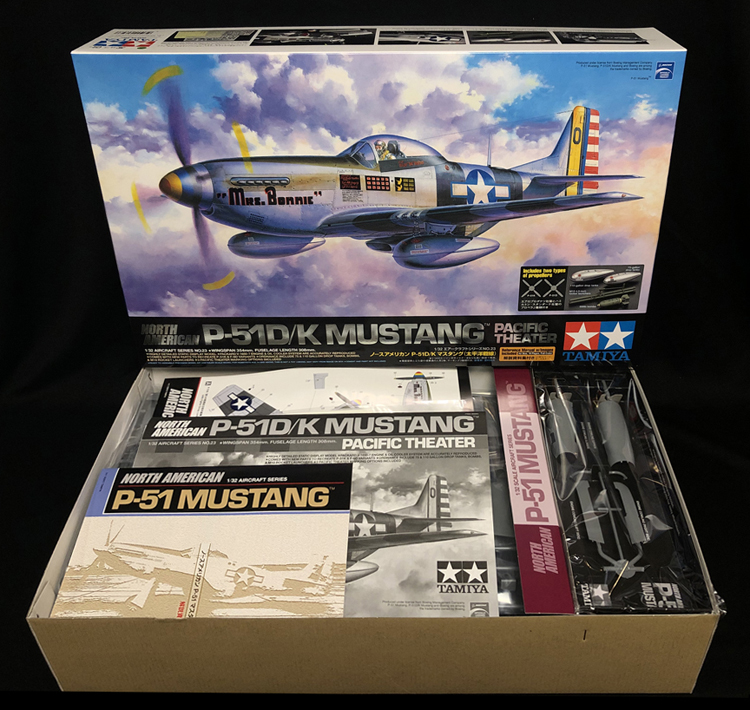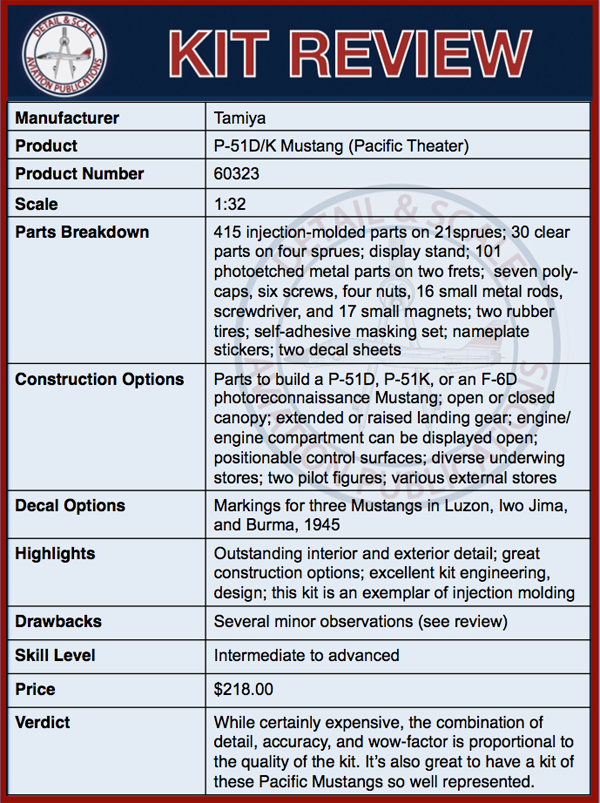Tamiya F-51D Mustang “Korean War” — 1:32 Scale


The P-51 Mustang is a legend of aviation. It was the highest-scoring Allied aircraft of WWII and continued to serve the fledgling U. S. Air Force into the Korean conflict. The P-51 is one of the most widely produced and popular model kits. More than 400 injection-molded kits of the Mustang have been released to date, from 1:144 to 1:24 scales. Nearly every plastic kit manufacturer has taken a crack at the P-51 since 1951. In 2011, Tamiya released their first 1:32 scale P-51D, and in 2012, it was followed by a P-51D/K with markings for the Pacific theater. In 2020, Tamiya’s big Mustang family has expanded again with the arrival of their F-51D “Korean War” issue of the kit. Let’s sit down with this Mustang and see what Tamiya has come up with here.

The origins of the P-51 go back to early 1940. The U.K. was seeking a stopgap fighter to help hold the line against the German Luftwaffe. Great Britain’s Purchasing Commission, interested in acquiring Curtiss P-40s, approached North American Aviation to build them under license for the RAF. Instead, North American pitched an alternative. They argued they could build a completely new fighter that would be easier and faster to produce, and that would also outperform the P-40. The British accepted the offer and placed an order for 340 of the new aircraft in March 1940. On September 9th, a design team headed by NAA’s “Dutch” Kindelberger finished the prototype NA-73X airframe. It was a rapid developmental process by any standard, even during wartime. A mere 102 days had passed between contract signature and roll-out.
The NA-73X first flew on 26 October 1940. It incorporated a revolutionary laminar flow airfoil wing derived from NACA flight test data and an innovative under-fuselage ducted engine cooling system. Mustangs were very fast, maneuverable, and well-armed. Early versions entered production in May 1941 and went into combat with the RAF 11 months later. These were powered by Allison engines and were typically equipped with two .50-calibre nose-mounted and four .30-calibre wing-mounted machine guns. The 1,100hp Allison V-1710-39 powerplant provided impressive performance, but only up to about 15,000 feet. RAF Mustang Mark Is and IIs were soon followed by the improved P-51As, Bs, and Cs operated by the USAAF and the RAF. British experimentation with the supercharged Merlin powerplant’s provided for outstanding high-altitude performance, and by mid-1943, Packard-built Merlin engines became standard for new build P-51s.
The definitive P-51D variant was fitted with a Plexiglas bubble canopy providing excellent 360-degree visibility, and the aircraft could reach around 440 MPH while its service ceiling was just shy of 42,000 feet. Armament consisted of six wing-mounted .50-caliber machine guns while underwing pylons permitted the use of range-extending drop tanks, along with rockets and bombs.
During WWII, P-51s saw action in the European, North African, Mediterranean, and Pacific theaters. Mustangs claimed 4,950 air-to-air kills. In USAAF service, P-51s escorted bombers over “Fortress Europe” beginning in 1943. Mustangs were used increasingly as ground attack aircraft as well.
Following the war, a large number of the P-51s were quickly phased out, though some were retained in secondary duties such as with the USAF Strategic Air Command. In 1948, the Mustang was officially re-designated F-51D (F for fighter). At the beginning of the Korean War in 1950, F-51Ds were pressed into combat once again, including those that had been placed into flyable storage. While the Mustang could certainly hold its own against North Korean YAK-9s, it was no match for the MiG-15. Therefore, its role shifted from that of an air superiority fighter to that of an air-to-ground attack platform. In Korea, the F-51D found a niche in close support and interdiction using unguided rockets and bombs. Yet, they were vulnerable to ground fire, owing to the Mustang’s liquid cooling system, and losses mounted. Mustangs flew with both the USAF and ROKAF. They had far better range and loiter time, and could thrive in unimproved operating conditions, unlike the early jets. F-51Ds were withdrawn from the front lines upon the arrival of the USAF F-84 Thunderjet in 1953. Back home, the “Cadillac of the Skies” served with Air National Guard Units until 1957 and the last Mustang in USAF service was retired in 1978. Today, a handful of P-51s fly as warbirds in the hands of private owners.

Tamiya’s 1:32 scale F-51D “Korean War” kit contains 405 medium grey injection-molded parts on 19 sprues, 27 clear parts on three sprues, a four part-display stand, 101 photoetched metal parts on two frets, seven poly-caps, six screws, four nuts, 16 small metal rods, one screwdriver, 17 small magnets, and two rubber tires. There’s also a self-adhesive masking set and nameplate sticker for the display stand. The full instruction booklet organizes the build over 75 steps. Two decal sheets provide all the markings (including airframe stencils) for three Korean-War era F-51Ds:
- F-51D-5 44-12943, “Was that too Fast,” 12th Fighter Bomber Squadron, 18th Fighter Bomber Wing
- F-51D-5 44-73888, “Karin Ann,” 39th Fighter Intercept Squadron, 18th Fighter Bomber Wing
- F-51D-5 K-18, Republic of Korea Air Force
Strengths: The Tamiya F-51D is based directly on their earlier P-51D and P-51D/K releases, and it is no less stunning. This kit was a signature achievement of plastic model kit design and manufacturing with the first issue of the 1:32 scale Tamiya Mustang in 2011, and it remains so in 2020. This is the P-51D in this scale, by far and away.
A lot has been said about Tamiya’s big Mustang and arguably, it is pretty well known. Still, this F-51D has several new features beyond the subject matter on the decal sheet to accurately represent a 1950s Mustang.
The kit itself is exquisite in its recessed panel and rivet details (though, do see below). While complex, overall kit engineering is smart so that it builds easily and fits virtually perfectly. The details and building options are breathtaking. The detail in the cockpit is simply stunning for an injection-molded kit. Normally, my go-to is some aftermarket resin cockpit, but here, you don’t really need one. From the instrument panel to the cockpit sidewalls, the post-WWII AN/ARC-3 transceiver, SCR-522 transceiver, and the BC-453B receiver, decal cockpit data placards, gunsight, and photoetched metal shoulder harnesses and lap belts, it is hard to do better than this. An optional seated pilot figure with a Korean War-era P-1A flying helmet, goggles, and oxygen mask is included, along with another standing pilot figure wearing a leather jacket and a service cap. The clear parts possess beyond-perfect optical quality, and there’s an extended fairing around the windscreen to make gluing and painting all that much easier.
The kit also contains a complete Packard Merlin engine and all the associated gear (coolant tank, oil tank, carburetor and carburetor intake duct, various pipes, the engine oil filter, the supercharger, and intercooler assembly). The kit also provides the uncuffed paddle-blade (markings options A and B) and cuffed (markings option C) Hamilton Standard propeller blades. Overall, this scale engine does justice to the great Merlin, and it makes this scale modeler’s heart go pitter-patter. There are also with two types of exhaust stacks in the kit, and here, you go with the shrouded stacks. Also, the single piece upper engine cowling is positionable, with magnets that allow it to be both fixed to the model and removable. There’s also a new set of parts here in the F-51D kit for the slitted fuselage radiator access panel.
All of the control surfaces (ailerons, landing flaps, rudder, and elevators) are separate, moveable parts, as is the radiator exhaust door. The main gear wells are really outstanding (though see below) and all that’s missing is some plumbing. Many manufacturers have failed to capture the correct contour and shape of the wells, but Tamiya nailed it here. The main gear are also rich with detail and feature separate brake lines and photoetched oleos. The same attention and fidelity of detail is present in the tail wheel well and tail wheel. There are also option parts to build the Mustang with its gear up, and hence, the inclusion of the display stand.
In terms of armament, the kit provides optional closed or open left and right gun bays. If displayed open, you can show off the six .50-caliber machine guns and very nicely detailed ammo belts feeding the guns. The wrap-around gun port insert ensures that there will be no seams splitting the gun barrels in half (very thoughtful from a design point-of-view). Underwing stores provide several options, from six 5-inch HVAR rockets, two napalm bombs, two 500-pound bombs, and two 75-gallon drop tanks.
While the masking set is not pre-cut, it will still save scale modelers a lot of time making their own. The markings options are really impressive with colorful markings from the 18th FBW who became known as the “Truck Busters” for their exploits hitting North Korean ground convoys. The Republic of Korea markings are also unique, but the shark mouth on “Was That Too Fast” is impossible to pass up. The decals look great in terms of quality, register, color, and all other technical attributes.
Weaknesses: While exceptional, Tamiya’s F-51D kit is not perfect. It sure does get close, but a few things are worth noting. First, the extensive rivet detail atop the wings is technically inaccurate for an operational Mustang. To achieve laminar flow, most of the rivets and panel lines on the wings were filled with putty at the factory and then covered in silver paint. The kit has all the wing rivets properly represented in a manner that could be called the “inside-the-factory” appearance. The one saving grace is that these rivets are quite shallow and fine (unlike what can be seen in the Dragon kit). A little bit of Mr. Surfacer and some light sanding should make them go away as Mustang aerodynamics intended. It’s rare to say a kit has too much detail, but this is indeed the case here.
Be vigilant for some poorly-placed ejection pin markings on surfaces inside the main gear well, gun bay access panel, and several other areas of the kit. Some of these will be more aggravating to remove than others. I can’t say that I’m a fan (ever) of rubber tires for a model kit. It’s basically impossible to remove the molding seam separating the tire halves, and they break down over time. For replacements, I highly recommend the cast resin P-51 wheels produced by Barracuda Studios (https://www.barracudacals.com). While mentioned earlier that the clear parts are optically flawless, the seam going down the midline of the canopy will require messing with that optical quality, sanding it down and buffing it back into a crystal-clear state.

Once again, Tamiya was produced another spectacular and engaging 1:32 scale Mustang kit. The F-51D is beautifully represented here. The combination of detail, accuracy, and pure allure is impossible to beat. It’s also great to have a kit of a post-WWII Mustang, and one that possesses so many great virtues. Indeed, this kit has a hefty price tag, but its price is proportional to its quality. Still, shop around, as some retailers are selling it below its MSRP. Enjoy this kit – it’s something special for Mustang fans and extends an invitation to a very wide range of scale modelers.
Sincere thanks are owed to Fred Medel and George Canare at Tamiya America for their generosity in sharing this review sample with us. You can find them on the web at https://www.facebook.com/TamiyaUSA on the web at www.tamiyausa.com.
Haagen Klaus
Scale Modeling News & Reviews Editor
Detail & Scale


